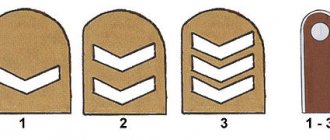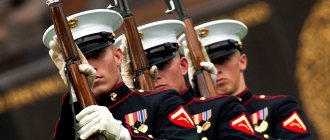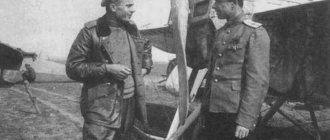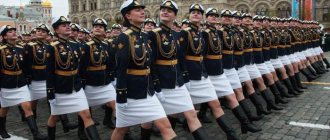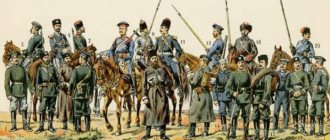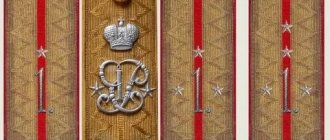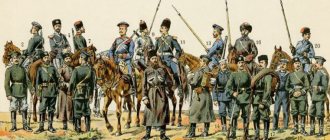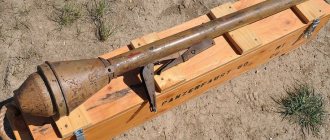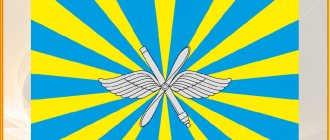The German word “Wehrmacht” (“Wehrmacht”) originally meant the army of the state, however, in Nazi Germany this was the official name of the Armed Forces of the Third Reich. When creating the Wehrmacht as a state army, much attention was paid to the uniform of soldiers, officers and generals of the resurgent German army.
Defeated and humiliated after the 1st World War, Germany, which experienced a terrible crisis with hyperinflation, when salaries were paid every day and were immediately given a break so that workers could spend it, because... by the evening it would have already depreciated; it could slowly begin to recover only after the conclusion of the Rapallo Agreement (aka the pajama agreement) between the German Republic and the Soviet Union in 1922. For both countries, this treaty was a breakthrough: for the USSR it was the first international treaty of a new state, and for Germany it was the first equal treaty after Versailles.
A short period of military-technical cooperation between Germany and the USSR began, which was soon brought to naught after Hitler came to power.
In 1935, the Third Reich adopted the “Law on the Construction of the Wehrmacht.” From that moment on, the provisions of the Versailles Treaty were officially rejected, and the army began preparing for a revanchist war.
However, in addition to the army, there were many auxiliary units in Germany, such as the Waffen-SS (from German Schutzstaffeln - “security units”), the Todt organization (“Organization Todt”) and others.
History of Wehrmacht and SS uniforms
Until 1936, Wehrmacht soldiers and officers also wore the uniform of the Reichswehr (German army during the First World War) with the national emblem (Hoheitszeichen) sewn onto the chest - the eagle with a swastika, well-known from the films. Only in 1936 did the transition to a new form officially take place.
The basis of the uniform was the military uniform (Waffen Rock) of the 1936 model. It was a tunic with five buttons and patch pockets in the color “Feldgrau” (field gray) with piping in the color of the military branch along the side and collar:
- carmine red color - War Ministry and Veterinary Service;
- crimson color - General Staff;
- white - infantry;
- grass-green color - motorized infantry (panzergrenadiers);
- light green color - mountain infantry, rangers;
- pink color - tank troops and anti-tank artillery (for combined arms uniforms);
- red - artillery;
- burgundy color - chemical defense parts and rocket artillery parts;
- black color - engineering troops;
- golden yellow color - cavalry and reconnaissance;
- copper-yellow color - motorized reconnaissance;
- lemon yellow color - signal troops;
- orange color - field gendarmerie and personnel replenishment bodies (military registration and enlistment offices);
- grayish-blue color - vehicle parts;
- cornflower blue - medical service,
- purple - priests of the Catholic and Lutheran churches.
As can be seen from the list, it was not difficult to get confused in such diversity. In the memoirs of one of the tank crews there is an episode when he captured one of the Wehrmacht generals, but he was not given an order, but only a medal “For Courage.” However, from the description it is clear that he captured a senior officer of the OKW General Staff (from Hauptmann to Oberst), and the reason for the confusion was that the General Staff officers wore general stripes on their uniform trousers. Moreover, an officer of the general staff did not mean at all that this was an officer from the main headquarters of the troops, but simply that this person served at the headquarters. And the headquarters can be at both the regiment and the division.
Jacket model 1936
However, Nazi Germany did not only have an army. The SS organization stands out separately (Schutzstaffeln - “security squads”). Initially formed as part of the assault troops (SA, Brown Shirts, NSDAP combat units), the SS quickly became a separate structure.
After the “night of long knives,” which ended with the destruction of the top of the SA and the separation of the SS into a separate structure, the SS became the main striking force of the ruling party and began the formation of combat units. In 1940, these units received the name SS Troops (die Waffen-SS). Also in service remained the general SS (Allgemeine SS), which did not take part in hostilities, but were used on the territory of the Third Reich. Service in the general SS was not considered military service.
In 1930, SS personnel received the infamous black uniform with runes. Only verified true Aryans could wear runes in their buttonholes. Other national units of the SS troops did not have the right to wear them. Instead of runic signs, national buttonholes or unit buttonholes were used.
Later, a ceremonial white uniform and a feldgrau uniform for field conditions were introduced.
The highest ranks of the Wehrmacht and SS, as well as those awarded the Knight's Cross, had the right not to fasten the top buttons of their overcoat so that their rank awards were visible.
It is also impossible not to mention Todt's form of organization. After the Anschluss of Czechoslovakia, the uniform of its army was used to outfit the organization's units. The trophy uniform was very different from the army one, even the color was olive, and not “field gray”.
Buttonholes of Todt units
The most famous uniform of the elite Die Waffen-SS unit
Dress uniform of Die Waffen-SS officers
Die Waffen-SS field uniform
Symbols and uniforms of the German army
Why uniform? Well, it must be said that in the Third Reich, a soldier had to be not only the most elegant representative of the nation, but also an ideal man. Accordingly, the uniform that was developed for this ideal man had to correspond to the hero of the nation. A lot of people worked on this and, probably, now quite a lot of people already know that the famous couturier, whose fashion house exists to this day, Hugo Boss, had a hand in the development and tailoring of the German uniform. Moreover, in 1931, Hugo Boss Sr. joined the National Socialist Party and began to design suits for the SS, SA, Hitler Youth, the highest party leadership in Germany and, naturally, for military units of various types of troops.
The Germans began to pay special attention to camouflage fabrics, because the new war implied new standards of combat operations and greater secrecy. At first this did not appear, and the first main association with the German army, which probably exists for most people to this day, is the gray uniforms with four pockets, very elegant (we must give them their due), very comfortable to wear, Made from durable and high quality fabrics.
If you remember the chronicle of the war, look at photographs of the British, French or us, then neither the English, nor the French, nor the Soviet uniform evoked a feeling of hidden threat. And the element of hidden threat was one of the main components of the conduct of combat operations of the German army. In his book, German General Staff officer Eike Middeldorff repeatedly addresses the issue of the hidden threat. The hidden threat was always meant to be created. It is not necessary to completely surround the enemy - you need to create the appearance of encirclement and move on; It is not necessary to take any drastic, unmotivated actions - it is enough to hint that they will happen. And this idea permeated literally everything, including the development of uniforms for the German army.
Group photo of young men from the Hitler Youth, 1933. (pinterest.com)
The basis for the main, let's say, German jacket, which was worn by both officers and soldiers, was taken from the model of the First World War, which was modified: with its appearance it gave greater status, greater smartness, and at the same time was extremely functional.
If you count how many varieties of uniforms German soldiers and officers had, you will get about ten varieties: it was a dress uniform, an exit uniform, a report uniform, an additional exit uniform, a casual uniform, a patrol uniform, a field uniform, and a work uniform. Accordingly, the form was supposed to have all kinds of unloading, as it is now called. A backpack was specially designed into which everything could be placed - this was for the infantry, for the soldiers. And numerous viewings of German parades and marching columns really evoke a feeling of this anxiety and fatality, which, apparently, was worked well not only by Hugo Boss, but also by ideologists and fashion designers.
It must be said that, naturally, all sorts of attributes were attached to the uniform: these are buttonholes, by which membership in one or another branch of the military was determined; these are the piping on the caps, which also made it possible to do this; and, accordingly, all sorts of elements that distinguished those who achieved something.
If we talk about German awards, they all had their own slang names. And it must be said that there was some kind of internal competition between the Wehrmacht, that is, the German army, and the NSDAP and the SS, respectively, since the SS was like a military application of the NSDAP, Hitler’s personal troops, party troops, because neither the Wehrmacht, nor the Luftwaffe, nor Kriegsmarine, no other troops in the German army were political. Not a single soldier or officer of the German army, in accordance with German law, could be a member of any party. As a matter of fact, the Wehrmacht never particularly liked the NSDAP and actively organized assassination attempts against Hitler, the last of which was almost successful.
A maximum of six awards could be worn on a German uniform. The Germans had laconic awards, not colored, with the exception of the German star, which in the army was called “scrambled eggs” for the presence of yellow. It was usually white or black metal. And, naturally, the most prestigious awards were the Iron Cross and the Knight's Cross of the Iron Cross, which were received by very, very few.
Presentation of the Iron Cross to Hanna Reitsch, 1941. (pinterest.com)
As for the SS, Reichsführer Heinrich Himmler, who was very interested in the German epic, was personally involved in the development of the style of uniform and much more. And everything that had anything to do with this, he sought to bring into the development and creation of the uniforms and symbols of the SS troops.
If we talk about the SS troops, then usually the associative series depicts people in black uniforms. But in fact, not all of them wore black uniforms every day, and the SS field units wore exactly the same gray or camouflage uniforms as all other military units in Germany.
Probably the standard perception stereotype is the presence of a skull and crossbones on the SS uniform. In fact, the story of the skull and crossbones has nothing to do with intimidating and intimidating the enemy. This is a very ancient German sign, which meant readiness for self-sacrifice, readiness to sacrifice oneself in the name of the Motherland. This symbol existed even in the time of Frederick of Prussia, and when he was buried, the coffin was covered with black cloth, at the corners of which a skull with two bones was embroidered, and the skull did not have a lower jaw. It was believed that this was the same skull that was on Golgotha, the skull of Adam, which lay at the base of the cross on which Jesus Christ was crucified.
This symbol was very common in Germany and during the First World War. Soldiers and officers ordered rings with the image of this skull. Naturally, when the struggle for political power began, everything that could work for this power was adapted by it, and Hitler and his entourage decided to use this symbol also in their favor. Himmler made some changes to the appearance of the skull and crossbones. Since he graduated from an agricultural educational institution, he noticed that the shape of the skull was not entirely correct - there was no lower jaw, and ordered the symbol to be modified in accordance with the anatomical parameters. It was precisely this anatomically correct skull that appeared as a symbol of the SS troops and, first of all, the “Totenkopf” division, which was very, very active on all fronts during the Second World War.
It must be said that the beginning of hostilities on the Eastern Front brought its own severe adjustments to the life of the German army. Naturally, German soldiers and officers had greatcoats. However, the Germans initially did not intend to fight in winter, and their overcoat was, rather, demi-season and for cool weather, but not for the 30- and 40-degree frosts that they had to face during the fighting in the winter of 1941/42. Accordingly, this presented the German uniform designers with the task of making clothes warm. And this form appeared in 1942. It was a reversible jacket, white on one side, gray on the other, or in protective camouflage (it was either in the form of broken glass or in the form of water stains), which had pockets that could be turned out inside out, which was decently insulated and which could be worn on All. This was probably the first shapeless uniform that absolutely did not hinder movement and made it possible to work quite comfortably in any weather conditions, including even snow.
The Death's Head Division advances, 1941. (pinterest.com)
A separate development of the form was carried out for Africa. One of the commanders in Rommel's Afrika Korps writes in his memoirs that the first impressions of the uniform they received for the desert war were quite stunning, because both the shorts and the jacket were thick. In the daytime, when the temperature reached forty degrees or more, it seemed ridiculous; it was very hot. But the temperature differences in the desert were so great that by nightfall this form turned out to be perfectly suitable.
It turns out that the uniform not only determines the appearance, not only affects the psychology of the enemy and the psychology of those who wear this uniform, but also performs a huge number of functions.
A few words about the swastika as a symbol of the Third Reich. So, the swastika is a very ancient symbol. When the development of Nazi symbols was going on, for the NSDAP everything in one way or another revolved around a cross of one form or another: after all, the cross was a standard German symbol for many centuries, starting with the same Teutonic knights.
Actually, the swastika is a Tibetan, Buddhist and Hindu symbol that is many, many thousands of years old and symbolizes the movement of the sun. And if you visit India, you will see swastikas of all sorts and stripes painted on anything: on houses, on cars, on counters...
Accordingly, the rigid form of the swastika apparently greatly appealed to Hitler and Himmler. She was very laconic. And if we remember that the Nazi banners were red with a white circle with a swastika in the middle, and the German communist banners were red with a white circle with a black hammer and sickle, then at a great distance all this was perceived uniformly, and at the beginning of the struggle for influence To society, all this looked like variations on the same theme. One way or another, the swastika took root in Germany, but it was not a national symbol, but a political one. She was not a symbol of the Wehrmacht. And, moreover, if we recall the conflict between the commander of Jagdgeschwader-77 Gordon Gollob and Goering, who accused him of cowardice and insufficient effectiveness of actions, then Gollob simply ordered to paint over the swastika on the Messerschmitts of his division. So they flew throughout the war without a swastika on their tails. Well, in general, there were quite a lot of such precedents.
Erwin Rommel during the fighting in Africa. (pinterest.com)
A few words about what the German infantry looked like. As mentioned above, privates and officers had about ten varieties of uniforms that they wore. Basically, this uniform was gray, as we usually say, mouse-colored. The question arises: why did the Germans choose gray? But in reality, in battle conditions, when dust, dirt, etc. rises, everything becomes gray. You can read Remarque or someone else who wrote about the war: dust, dust and dirt. Accordingly, gray color is the most adaptive and most invisible.
It must be said that at the first stage of the war, the Germans painted their planes according to the scheme: light green and dark green on top, pale blue on the bottom. But starting in 1942, they began to paint airplanes and fighters gray and dark gray, dove-gray, the shade of a dove’s wings. Why? Because at a short distance this plane was already hiding and blurring. Gray is quite faceless, as the Strugatskys wrote, “the gray ones start and win.” And, indeed, as an element of camouflage it was effective. Our aviation, too, since 1943, has adapted gray colors for greater stealth.
What is special about the Wehrmacht uniform?
The uniform of the German army at the beginning of World War II compared favorably with the uniform of other belligerent armies. In the Wehrmacht, they were the first to indicate belonging to a participating country (eagle), the types of troops were clearly designated, and there was no confusion with the ranks of officers for the soldiers of their army.
However, frosty Russia quickly revealed the shortcomings of the uniform: there are cold overcoats, especially when the Red Army en masse changed into quilted jackets. That is why it was so often possible to see captured Germans dressed haphazardly in the winter. In the summer, it was terribly hot in field jackets, which forced the soldiers to unbutton and roll up their sleeves. This fact received a lot of attention in Soviet cinema.
But the author cannot fail to mention the following fact. The color, appearance and shape of the Wehrmacht is very well ingrained in the genes of the Russian people. The author somehow accidentally saw people in the uniform of Hitler’s army, and although he had never seen such a uniform in person in his life, there was a very clear message from the subconscious that he had to go and kill them. Due to the lack of a machine gun at hand, the author approached the people in the feldgrau almost unarmed and found out that they were actors from the film set. Therefore, the heart let go of hatred, and everyone remained unharmed.
Wehrmacht uniform
General Staff officers
The officers working in the General Staff performed important functions and were equipped with a uniform similar to a general's. The buttonholes on the collar of the uniform (without patterns or ornaments) were crimson, as were the piping and stripes on the trousers. The insignia was located on shoulder straps that had a crimson lining. The headdress is a cap with a scarlet edging and a scarlet band. The helmets (if they had to be worn) were the same as those worn by the dragoons (the Bavarians preferred the infantry version).
Lieutenant General, 1915. The pattern on the buttonhole was called “Alt-larisch” and represented the sewing of a regiment of the Prussian army. It was preserved on the uniform introduced in 1915. The code of Kaiser Wilhelm II is stamped on the belt buckle
On the right shoulder, officers of the General Staff also wore a silver cord aiguillette. It was usually stitched with threads in the colors of the national flag, just like the cord for the shoulder straps. At the front, the aiguillette was usually replaced by an armband. The uniform was modified in accordance with the changes introduced for infantry officers.
Share link
Special differences between the SS form and other German forms
The SS were probably the first to introduce so-called camouflage patterns. Moreover, the Flektarn pattern introduced by the SS units is still used by the Bundeswehr. This type of used camouflage is supplied all over the world: in both Russia and Ukraine you can see people wearing camouflage of this color. To be fair, it should be noted that the modern name “Flektarn” was introduced in the 1970s. The camouflage was originally called "Platanenmunster".
Reversible camouflage jacket in platanenmuster autumn side out
The camouflage uniform was double-sided - spring-summer and autumn-winter colors. Summer colors were green, winter colors were closer to variations of orange. Badges indicating rank were sewn onto the uniform. The color of the stripes is green.
At first, the SS cockade was considered the “Death’s Head” (der Totenkopf), however, after the formation of detachments, and later divisions with this name, the cockade was changed to the imperial image of an eagle.
Untersturmführer (lieutenant) of the SS troops in a camouflage jacket in platanenmuster colors with the summer side facing out
SS UNITS
Initially (from 1925) members of the SS wore the usual CA uniform, while they wore black caps with a death's head, black ties (the party badge was often used as a pin), black breeches and an armband with a black border. On November 9, 1925, this form was approved as “traditional” (completely out of use by 1934). At first, the SS men wore a death's head on their caps with a round metal cockade with concentric rings in black, white and red.In the fall of 1929, the uniform of musicians of SS units was supplemented with black and white “swallow’s nests” - a kind of mantle.
In 1930, Himmler abolished the old brown uniform and black ties and introduced a new uniform, the black uniform. The new black uniforms were worn with breeches and knee-high boots, as well as officer's traveling belts. They usually wore a light tobacco-brown shirt.
The black open jacket, as part of the black uniform, was introduced on July 7, 1932. It was designed like an army jacket and was fastened with four metal buttons. The jacket had four pockets: two pleated patch pockets and two side welt pockets. For a waist belt, there were two belt loops on the sides of the jacket, and at the back the belt was supported by two buttons. Along the edge of the collar was a white or twisted black and white edging. At first, a uniform was also in circulation, fastened with three buttons, with rectangular flaps on the side pockets, but by mid-1934 the SS uniform was completely standardized. The black uniform, designed by Karl Diebitsch, took on its final form by 1934.
According to the "Organisationsbuch der NSDAP" in 1938 there were two types of uniform:
“a) service uniform;
b) dress code.
a) The service uniform consists of:
The caps are black, with a death's head and an emblem.
The uniform is black, with matte silver buttons, two patch pockets on the sides.
Turn-down collar with black and silver or silver cord at the collar.
Shoulder strap - black and silver or silver tones (on the right shoulder).
Rank insignia.
Armband with swastika with black trim (on the upper part of the left sleeve).
Brown shirt - with a black tie and party badge (for party members only).
Sleeve patches - on the lower part of the left sleeve. Black trousers tucked into boots. Hiking boots - black.
The sword belt and shoulder strap are black, the belt lock is matte gray.
A service dirk, an SS sword, black with a metal frame or a cleaver...
b) Small service uniform: as described above, but long cloth trousers, without a belt, a dagger in the left pocket of the uniform or overcoat.
c) The exit uniform consists of:
The caps are black, with a death's head and an emblem.
The weekend uniform is black with matte silver buttons, double-breasted, with wide lapels. Front and hem lapels are edged in white, two side welt pockets, turn-down collar with white or silver edge, no shoulder straps.
The collar tabs are black, with black-and-silver or silver edging, there is no armband with a swastika, but the emblem is embroidered in silver on the upper part of the left sleeve.
Brown shirt - with a black tie and party badge (for party members only).
Sleeve patches - on the lower part of the left sleeve.
Long trousers - black with white piping and a black stripe. Black boots are worn with long trousers.
Neither a sword belt nor a shoulder strap are worn with the dress uniform.
belt."
All part-time SS members, as well as a number of other SS members, wore black trousers with white piping and black boots instead of riding breeches and boots.
In 1936, SS members were ordered to wear a white shirt rather than a brown one on special occasions. At the same time, a club version of the uniform was developed for SS Fuhrers for attending public events. It consisted of a black tailcoat with silver aiguillette, shoulder straps on both shoulders and silver piping on the cuffs and bandage, a white vest and black untucked trousers with white stripes.
On June 27, 1939, officers received a white version of the everyday uniform, intended for use as a summer weekend uniform during the period from April 1 to September 31. White uniforms then appeared among soldiers, but with the exception of cavalrymen they were rarely worn.
A white jacket (similar in cut to a black one) was supposed to be worn with white untucked trousers, white leather boots and a cap with a white top (in some cases it was allowed to wear black breeches and boots with a white uniform). The personnel who served A. Hitler in the Imperial Chancellery and at his residence in the Berghof wore a special uniform, consisting of a white double-breasted jacket with SS insignia, black trousers with white piping and black patent leather boots. During the war, the SS eagle was worn on the left forearm of the jacket. During the war, the SS members who remained in the rear practically stopped wearing black uniforms - it began to evoke extremely negative feelings among the German population, because clearly showed that its owners were not fighting at the front. Therefore, after 1939, a large number of black uniforms accumulated in warehouses. In 1942, large numbers of black uniforms were handed over to the German police or sent to the occupied territories, where they were transferred to auxiliary police forces. The SS symbols were removed from this uniform, a green collar and cuffs were added, and new insignia were sewn on. Black uniforms with special symbols were also worn by members of the Germanische SS.
In 1938, a new pale gray uniform was introduced for members of the Allgemeine SS, which generally repeated the cut of the black uniform, but had two shoulder straps and instead of an armband, an SS eagle was placed on the sleeve. The employees of the Main Directorates were the first to receive the new uniform, and later the remaining members of the Allgemeine SS. During the war, the pale gray uniform gradually began to be replaced by SS officer uniforms. In occupied territory, members of the Security Police and SD, as well as members of the Allgemeine SS, almost exclusively wore SS officer uniforms. In 1944, the wearing of black uniforms (previously reserved exclusively for special occasions) was finally abolished.
After the creation of SS reinforcement units in 1934, the development of a new form began. In 1935, an earthy-gray field uniform was introduced for them, differing from the previous black one only in color. SS Death's Head units received an earthy brown uniform. In 1937, all SS reinforcement units received feldgrau uniforms.
In May 1940, the SS troops adopted an army uniform in feldgrau color with four patch pleated pockets and a feldgrau collar without piping. The jacket was fastened at the neck with five metal buttons and had shoulder straps on both shoulders. The uniform, riding breeches and trousers were usually made of wool with the addition of artificial fiber (viscose). The trousers were supported by suspenders (no longer used towards the end of the war). In 1942, side and then chest pockets began to be made without pleating, and from 1943, pocket flaps became rectangular. On September 25, 1944, a new uniform in Feldgrau-44 color (with a blue-gray tint) was introduced: a short jacket and untucked trousers. The jacket had four pockets: two large breast pockets (without pleating) with rectangular flaps and two internal ones. The jacket was fastened with six buttons (the top button was traditionally not fastened).
A tropical version of the SS uniform was also developed - a cap, a sand-colored uniform, shorts and boots. It was widely used in the summer on the southern sector of the Soviet-German front. This uniform was worn with short-capped boots, which replaced expensive boots as the war progressed.
Initially, the SS men wore a black overcoat. A black overcoat with white ammunition was very often worn by soldiers of the Leibstandarte Adolf Hitler.
Simultaneously with the introduction of the gray uniform, the gray overcoat was introduced. The double-breasted overcoat provided reliable protection from the wind. For sentries there was a version of the same overcoat, made from thicker cloth. Officers of the rank of Oberführer and above received permission not to fasten the top three buttons of their overcoats so that the colored flaps were visible (they were entitled to gray lapels on their overcoats). Since 1941 holders of the Knight's Cross also received the right not to fasten the top buttons.
However, the overcoats turned out to be “weak” against the harsh Russian winters, so in the fall of 1942 the troops fighting on the Soviet-German front received thick parkas with a hood and lining made from a mixture of wool and rayon. A sheepskin hat with earflaps was usually worn along with the parka. Due to the fact that parkas took a long time to dry after washing, they were usually dressed in cotton suits. In addition, in winter the SS troops often wore a fur-lined jacket with a hood, made of water-repellent material.
In 1938, SS tank crews received black tank uniforms of the Wehrmacht tank forces. It was a short, double-breasted black jacket fastened with hidden buttons. Because The top three buttons were usually not fastened, and the collar of the brown shirt and the knot of the black tie were visible. The low sleeves had a vent with buttons, and a drawstring with a drawstring ran along the waist. Unlike the army jacket, the SS jacket had a side cut vertically (and not diagonally), and there was no central seam on the back. In September 1944, the crews of self-propelled guns received their own uniform: it was similar to the tank crew uniform, but was made of gray cloth.
In the SS field uniform there was also a white summer uniform, which had several variations. The first type of uniform had no pockets, the buttons were internal, and the only insignia on it were field shoulder straps. The second type of uniform was no different in cut from the standard SS field uniform. Its collar could be open or closed (in the latter case it could be white or dark green). The summer uniform could be worn from April 1 to September 30.
Women's SS units, who performed mostly clerical functions, had their own uniform, consisting of a black cap with an SS eagle, a gray jacket, a gray skirt, stockings and shoes.
Wehrmacht women's uniform
After the outbreak of hostilities in the European TBD (theater of combat), there was a need to expand support units and personnel. These positions were well suited to be filled by female military personnel. Therefore, by OKW order No. 1085 of 01.10.1940, first the Women's Auxiliary Communications Service (from German: Nachrichtenhelferinnen) was created, and then other auxiliary services. Army uniforms were provided for female soldiers.
The Waffen-SS women's uniform consisted of a gray jacket and skirt, as well as a black cap with the image of the German eagle.
Female SS uniform
The most famous female member of the SS was probably Irma Grese. Rape by her own father at the age of 12 (according to other sources, brother, uncle), hard village life greatly influenced the consciousness of the young girl, giving birth to sadistic tendencies in her soul. Having voluntarily joined the auxiliary units of the SS in 1942, she was appointed as a guard at the Ravensbrück concentration camp. Then she was transferred several more times to other camps. And everywhere she happily tortured female prisoners of the concentration camp, she loved to shoot the prisoners she chose. The list of tortures used by her is very extensive. In fact, torture gave her sexual pleasure. The torture was followed by sexual orgies with the guards and commanders of the concentration camps. In 1945, she was captured by the British, sentenced to death and hanged in prison.
Irma Grenze - "The Blonde Devil"
Officer uniforms
During the Third Reich, uniforms changed constantly, from the use of World War I uniforms to the dandy uniforms of the late 30s and early 40s, to the simplification, if not absence, of uniforms of the Hitler Youth in 1945.
Uniforms of Wehrmacht officers
It should also be noted that, as in all armies of the world at that time, the main type of footwear was boots.
Therefore, uniform long trousers and breeches were adopted:
- Long trousers (lange Tuchhose) - for wearing with short shoes (boots, etc.);
- Trousers to be worn with boots (Reithose für Bereitene). They are sometimes called riding breeches or breeches. The statutory name for such trousers in the Red Army is harem pants. The author saw the times when such trousers were still issued as uniforms.
The trousers were either feldgrau or white, depending on the uniform.
Equipment
The generals were armed with pistols (Luger model 1908) in a brown holster, and also had a tablet and binoculars. They could also wear an officer's sword of the 1889 model or a cavalry saber with a corresponding sword belt. Later, instead of a sword, a dagger appeared. Orders and medals were often worn on the collar or ribbon attached to the edge of the uniform.
The only real changes to the general's uniform during the war were the introduction of a steel helmet and gas mask, as well as the elimination of colored piping.
Marks of Excellence
The ranks of the Wehrmacht differed depending on the type of troops. That is, for example, the description was not added - senior lieutenant of the medical service, but there was Oberarzt - senior doctor, although the army senior lieutenant was called Oberleutnant.
The shoulder straps of soldiers and sergeants differed from those of officers. Against the background of clean soldier's shoulder straps, twisted officer's, and even two-color general's shoulder straps were very clearly visible. Therefore, officers on the front line had to hide their shoulder straps, turning them inside with insignia, or even remove them altogether.
Waffen-SS officers had SS insignia on one buttonhole and rank insignia on the other.
Marks of Excellence
Shoulder straps
The kings of Bavaria, Saxony and Württemberg still had the right to influence the form of their troops. The main distinguishing features were galloon on the red buttonholes and a braided cord of metal threads on the shoulder straps. The shoulder straps had a red lining, rounded ends and were secured with a silver or gold button. Embroidery was done with gold or silver thread.
Major of the General Staff, 1915. Although this staff officer wore a light gray cap, his uniform also included a dragoon helmet. The cap has a natural or artificial silk lining and an inner leather band that gives it shape and absorbs sweat. The stripes on the trousers are crimson
On the shoulder straps of field marshals (there were six of them in the German armed forces) there were emblems of crossed batons, colonel generals had three stars, generals had two stars, lieutenant generals had one star each, major generals had shoulder straps without any - or jewelry. The buttons were made of gold, with the exception of the uniforms of the generals from Bavaria and Mecklenburg, who had them in silver. Later gray buttons were adopted.
The generals wore caps of the 1910 model with a double cockade (imperial and state), red piping, red band and leather visor. They also wore helmets with a pointed top, usually with a cover. As a rule, this was a dragoon version of the helmet. Infantry versions are also known.
General Alexander von Kluck (center) and his staff. Von Kluck's 1st Army was defeated on the Marne in 1914. Officers of the European armies of those years often wore mustaches, although this did not comply with the regulations
The light gray model of the general's overcoat was approved in 1903. The overcoat had shoulder straps, a dark blue turn-down collar (light blue for the Bavarians, with blue piping for the Saxons), red piping on the front edge and on the cuffs, as well as red rectangular lapels.
Some generals preferred to wear the uniform of the regiments in which they had previously served, but with the appropriate insignia. General Paul von Hindenburg preferred the uniform of the 3rd Regiment to the Foot Guards. The Crown Prince of Prussia wore the uniform of the regiments of which he was chief. In addition, some retired generals were brought back into service and forced to wear slightly outdated uniforms, including blue coats and frock coats. When not on duty, generals wore double-breasted uniforms of a different cut, which were called “litevka” (tunic).
Camouflage
After the separation of the SS troops (Waffen SS) from the general SS (Allgemeine SS), field uniforms for the SS troops began to be developed.
It included:
- helmet cover;
- jacket;
- face mask.
As mentioned earlier, the Waffen SS were the first to use uniforms that concealed the fighter on the ground.
After some time, having appreciated the new product, the Wehrmacht also began to use camouflage for reconnaissance groups.
Wehrmacht uniform camouflage
To summarize, we can say that the German war machine, even in the matter of uniform, gave a huge uniform to all countries that participated in the Second World War.
All that remains is to say a huge thank you to our ancestors who managed to destroy such a monster.
